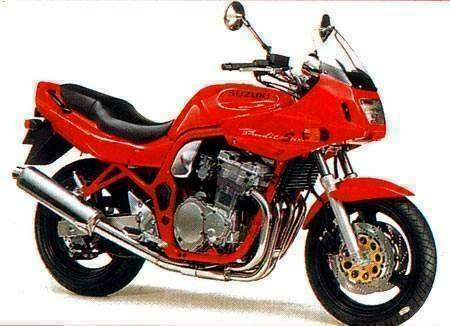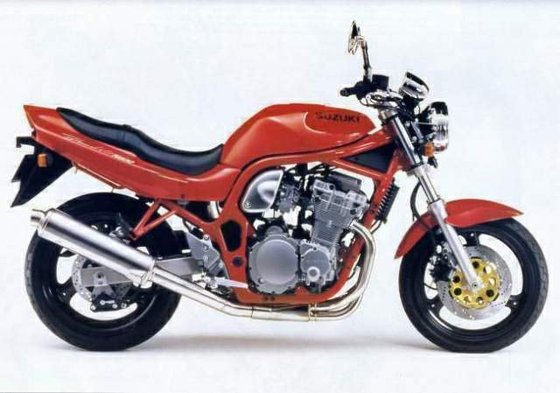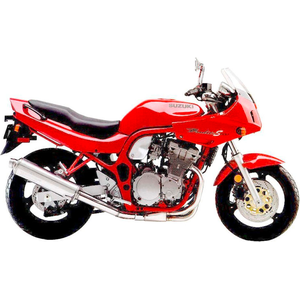Suzuki GSF 600 S Bandit [1996–1999] Review: The Unapologetic All-Rounder

Introduction
The Suzuki GSF 600 S Bandit is a motorcycle that refuses to fade into obscurity. Introduced in 1996 as the faired sibling to the naked Bandit 600N, this bike carved out a niche as a budget-friendly sport-tourer with a rebellious streak. Designed for riders who wanted versatility without breaking the bank, the Bandit S combined Suzuki’s legendary reliability with just enough performance to keep things exciting.
Climbing onto the Bandit S today, you’re immediately struck by its no-nonsense attitude. The half-fairing—a simple, frame-mounted piece—hints at touring capability, while the exposed engine and upright riding position remind you this isn’t a fully-faired couch on wheels. It’s a bike that says, “I’ll do the job, but I’ll have fun doing it.” Let’s dissect why this ’90s workhorse remains a compelling choice for riders who value practicality with a side of adrenaline.
Engine and Performance
The Heart of the Bandit
At the core of the GSF 600 S lies a 599 cc air/oil-cooled inline-four engine, a derivative of Suzuki’s GSX-R lineage. With 77 hp (57.4 kW) at 10,500 rpm and 54 Nm (39.8 lb-ft) of torque at 9,500 rpm, this powerplant prioritizes mid-range punch over top-end frenzy. The engine’s character is unmistakably old-school: carbureted (Keihin CVK32s), slightly vibey above 7,000 rpm, and blessed with a raspy exhaust note that’s more gritty symphony than sterile hum.
Key Stats:
- 0–100 km/h (0–62 mph): 4.1 seconds (claimed)
- Top Speed: 211 km/h (131 mph)
- Fuel Economy: 5.3 L/100 km (44.5 US mpg)
Riding the Powerband
Throttle response is linear, with a satisfying surge from 6,000 rpm onward. Below that, the Bandit feels docile—perfect for city commutes—but twist the grip past halfway, and the inline-four wakes up with a growl. The 6-speed transmission is slick, though the clutch can feel heavy in stop-and-go traffic.
The Bandit’s party trick is its flexibility. It’ll lug around town at 3,000 rpm in sixth gear without complaint, yet still hit an indicated 130 mph (209 km/h) on a open stretch. That said, it’s outgunned by modern liquid-cooled rivals like the Yamaha Fazer 600, which offers sharper throttle response and a 15 hp advantage. But what the Bandit lacks in peak power, it makes up for in mechanical simplicity and durability.
Handling and Chassis
The “Good Enough” Philosophy
Suzuki kept costs low with a basic but effective chassis: a steel double-cradle frame shared with the RF600 sports-tourer. Paired with a 41 mm telescopic fork and a monoshock rear (adjustable for preload and rebound), the Bandit strikes a balance between stability and agility. At 218 kg (481 lbs) wet, it’s no featherweight, but the weight distribution feels neutral.
By the Numbers:
- Wheelbase: 1,430 mm (56.3 in)
- Front Suspension Travel: 130 mm (5.1 in)
- Rear Suspension Travel: 121 mm (4.8 in)
Cornering Confidence
Push the Bandit into a bend, and it responds with predictable manners. The suspension soaks up mid-corner bumps decently, though aggressive riders might find the damping too soft for hard charging. The Bridgestone Battlax tires (110/70-17 front, 150/70-17 rear) offer ample grip for spirited riding, but upgrading to modern rubber transforms the bike’s cornering poise.
Braking duties are handled by dual 290 mm front discs with 2-piston calipers and a single 240 mm rear disc. Stopping power is adequate, but the setup lacks bite compared to radial-mount systems. Swapping to sintered pads and steel-braided lines (available at MOTOPARTS.store) is a worthwhile upgrade.
Comfort and Ergonomics
Touring Lite
The Bandit S’s half-fairing is its defining feature. While it won’t deflect wind like a full fairing, it reduces chest pressure at highway speeds (100–120 km/h / 62–75 mph). The riding position is upright, with a low 800 mm (31.5 in) seat height that accommodates shorter riders. The seat itself is firm for the first hour but proves surprisingly tolerable on longer hauls.
Practical Touches:
- Fuel Capacity: 19 L (5.0 US gal) → ~350 km (217 mi) range
- Luggage Options: Aftermarket racks easily mount soft panniers
Vibration is minimal below 7,000 rpm, making the Bandit a relaxed companion for daily rides. That said, the mirrors blur at higher revs, and the square headlight fairing (pre-2000 models) looks dated next to modern designs.
Competition
The 1990s Middleweight Showdown
The Bandit S faced fierce rivals in its heyday. Here’s how it stacks up:
| Model | Suzuki GSF 600 S Bandit | Yamaha FZS 600 Fazer | Honda CB600F Hornet |
|-------------------|-------------------------|----------------------|---------------------|
| Engine | 599 cc inline-four | 600 cc inline-four | 599 cc inline-four |
| Cooling | Air/oil | Liquid | Liquid |
| Power | 77 hp @ 10,500 rpm | 90 hp @ 11,500 rpm | 95 hp @ 12,000 rpm |
| Weight | 218 kg (481 lbs) | 199 kg (439 lbs) | 185 kg (408 lbs) |
| Key Strength | Mid-range torque | High-revving thrills | Agile handling |
Yamaha Fazer 600: The Fazer’s liquid-cooled engine delivers more peak power and a thrilling top-end rush. It’s also lighter and sharper in corners, but the riding position is more aggressive, and the fairing provides less wind protection.
Honda Hornet 600: The Hornet is a stripped-back hooligan. Its higher-revving engine and minimalist design appeal to urban riders, but it lacks the Bandit’s touring-friendly ergonomics and torque-rich midrange.
Verdict: The Bandit S isn’t the fastest or most refined, but its blend of comfort, torque, and durability makes it a jack-of-all-trades. It’s the bike you ride year-round—rain or shine, highway or backroad.
Maintenance
Keeping the Bandit Alive
The GSF 600 S is famously low-maintenance, but age demands vigilance. Here’s what to watch:
- Valve Adjustments: Check every 24,000 km (15,000 mi).
- Intake: 0.10–0.15 mm (0.004–0.006 in)
-
Exhaust: 0.18–0.23 mm (0.007–0.009 in)
-
Carburetor TLC: Clean jets annually if stored with ethanol fuel. Upgrade to a K&N air filter for smoother airflow.
-
Chain Care: The 110-link chain requires frequent lubrication. Replace worn sprockets (15T front/47T rear) with DID or RK kits.
-
Brake System: Flush fluid every 2 years (DOT 4). Consider EBC HH sintered pads for improved bite.
-
Oil Changes: 3.5 L (3.7 US qt) with filter. Use 10W-40 motorcycle oil—MOTOPARTS.store stocks Motul and Liqui Moly.
Common Upgrades:
- Suspension: Öhlins or YSS shocks transform rear damping.
- Exhaust: A Delkevic slip-on saves weight and amplifies the inline-four howl.
- Lighting: LED headlight bulbs improve nighttime visibility.
Conclusion
The Suzuki GSF 600 S Bandit isn’t a cutting-edge machine, and it doesn’t pretend to be. What it offers is raw, honest motorcycling—a bike that thrives on reliability and rider engagement. Whether you’re threading through traffic, carving backroads, or racking up highway miles, the Bandit delivers with a grin-inducing lack of pretension.
For owners looking to refresh their ride, MOTOPARTS.store offers everything from OEM-spec replacement parts to performance upgrades. Because even a 25-year-old Bandit deserves to feel young.

The Bandit S: Proof that sometimes, "good enough" is exactly what you need.
Specifications sheet
| Engine | |
|---|---|
| Stroke: | Four-stroke |
| Ignition: | Digital Transistorized |
| Max power: | 57 kW | 76.0 hp |
| Max torque: | 54 Nm |
| Fuel system: | 4 x Keihin CVR32 carburetors |
| Max power @: | 10500 rpm |
| Displacement: | 599 ccm |
| Max torque @: | 9500 rpm |
| Configuration: | Inline |
| Cooling system: | Air/oil cooled |
| Compression ratio: | 11.3:1 |
| Number of cylinders: | 4 |
| Dimensions | |
|---|---|
| Wheelbase: | 1430 mm (56.3 in) |
| Dry weight: | 196 |
| Wet weight: | 218 |
| Seat height: | 800 mm (31.5 in) |
| Ground clearance: | 165 mm (6.5 in) |
| Fuel tank capacity: | 19 L (5.0 US gal) |
| Drivetrain | |
|---|---|
| Final drive: | chain |
| Chain length: | 110 |
| Transmission: | 6-speed |
| Rear sprocket: | 47 |
| Front sprocket: | 15 |
| Maintenance | |
|---|---|
| Rear tire: | 150/70-17 |
| Engine oil: | 10W40 |
| Front tire: | 110/70-17 |
| Idle speed: | 1200 ± 100 rpm |
| Brake fluid: | DOT 4 |
| Spark plugs: | NGK CR9EK |
| Spark plug gap: | 0.7 |
| Forks oil capacity: | 1.04 |
| Engine oil capacity: | 3.5 |
| Engine oil change interval: | Every 5000 km or 2 years |
| Valve clearance (intake, cold): | 0.10–0.15 mm |
| Valve clearance check interval: | 24,000 km / 15,000 mi |
| Valve clearance (exhaust, cold): | 0.18–0.23 mm |
| Recommended tire pressure (rear): | 2.5 bar (36 psi) |
| Recommended tire pressure (front): | 2.25 bar (33 psi) |
| Chassis and Suspension | |
|---|---|
| Frame: | Double cradle, tubular steel |
| Rear tire: | 150/70-17 |
| Front tire: | 110/70-17 |
| Rear brakes: | Single 240 mm disc, 1-piston caliper |
| Front brakes: | 2 x 290 mm discs, 2-piston calipers |
| Rear suspension: | Link-type monoshock, 4-way adjustable rebound damping, 7-way adjustable preload |
| Front suspension: | 41 mm telescopic fork, oil damped |



















